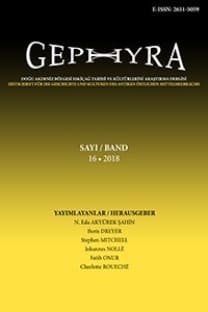Dört Kardeş, Bir mezar: I.Milet VI 2, 783 için Tamamlama ve Yorum
epigrafi, mezar yazıtları, silme, tamamlama, sahiplik, aile tartışması, Miletos
Four Brothers, One Grave: Reconstruction and interpretation of I.Milet VI 2, 783
epigraphy, grave inscription, erasure, reconstruction, ownership, family dispute, miletos,
___
- N. A. Beis, Über die Konstruktion von διαφέρειν (‚gehören’) mit dem Genetiv, Glotta 2, 1910, 118-124.
- K. Harter-Uibopuu, Synchōresis, Parachōresis, Ekchōresis. Formen der Übertragung von Grabrechten im kaiserzeitlichen Kleinasien, in: L. Gagliardi – L. Pepe (Hg.), Dike. Essays on Greek Law in Honor of Alberto Maffi, Mailand 2019, 151-182.
- K. Harter-Uibopuu – K. Wiedergut, „Niemand anderer soll hier bestattet werden...“. Grabschutz im kaiserzeitlichen Milet, in: G. Thür (Hg.), Grabrituale. Tod und Jenseits in Frühgeschichte und Altertum, Wien 2014, 147-171.
- J. Stauber, Griechische und Lateinische Inschriften aus Mysien und der Troas (im Erscheinen, die Inschriften abrufbar über die Datenbank des Packard Humanities Institute, epigraphy.packhum.org/ regions/633).
- J. Kracker – M. Scholz, Zur Reaktion auf die Constitutio Antoniniana und zum Umfang der Bürgerrechtsverleihungen anhand des kaiserlichen Familiennamens Aurelius, in: B. Pferdehirt – M. Scholz (Hg.), Bürgerrecht und Krise. Die Constitutio Antoniniana 212 n. Chr. und ihre innenpolitischen Folgen, Mainz 2012, 67-75.
- E. Miranda, La comunità giudaica di Hierapolis di Frigia, EA 31, 1999, 109-156.
- Th. Pekáry, Inschriftenfunde aus Milet 1959, MDAI(I) 15, 1965, 118-134.
- F. A. Pennacchietti, Nuove iscrizioni di Hierapolis Frigia, AAT 101, 1966/67, 287-328.
- K. Praust – K. Wiedergut, I.Milet VI 2, 570: Rekonstruktion und Interpretation einer bemerkenswerten Grabinschrift, Chiron 49, 2019, 69-92.
- T. Ritti, Iura Sepulcrorum a Hierapolis di Frigia. Nel quadro dell’epigrafia sepolcrale microasiatica. Iscrizioni edite e inedite, in: E. Miranda (Hg.), Libitina e dintorni, Rom 2004, 455-634.
- L. Robert, Hellenica 13, Paris 1965.
- W. Schubart, Einführung in die Papyruskunde, Berlin 1918.
- A. Wilhelm, Zu den „Urkunden der Ptolemäerzeit“ und anderen Papyri, AnzWien 74, 1937, 69-92.
- ISSN: 1309-3924
- Yayın Aralığı: Yılda 2 Sayı
- Başlangıç: 2004
- Yayıncı: Nalan Eda AKYÜREK ŞAHİN
Nakoleia Territoryumunda Eski Phrygce Yazıtlı Idol Şeklinde Bir Stel
Rahşan TAMSÜ POLAT, Yusuf POLAT, Alexander LUBOTSKY
Bursa Arkeoloji Müzesi’nden Bir Orta Bizans Damgası
Eskişehir Müzesi’nden Yeni Hosios ve Dikaios Adakları
Nalan Eda AKYÜREK ŞAHİN, Hüseyin UZUNOĞLU
Dört Kardeş, Bir mezar: I.Milet VI 2, 783 için Tamamlama ve Yorum
Eskişehir Müzesi’nden Yeni Yazıtlar
Helenistik Dönem Lykia’sının Kuzey Sınırında Masa Dağı
Juliopolis Teritoryumundan İki Yeni Miltaşı
Sembolden Benzerliğe: Yunan-Pers Geleneğinde Sikke Portesinin Ortaya Çıkışı
İmparator Tiberius ve İ.S. 14 Tarihli Yeni Bir Bronz Tablette Onun praecipua legionum cura’sı
Fethiye Etrafındaki Antik Yol Hatları ve Yeni Likçe Yazıtlar
